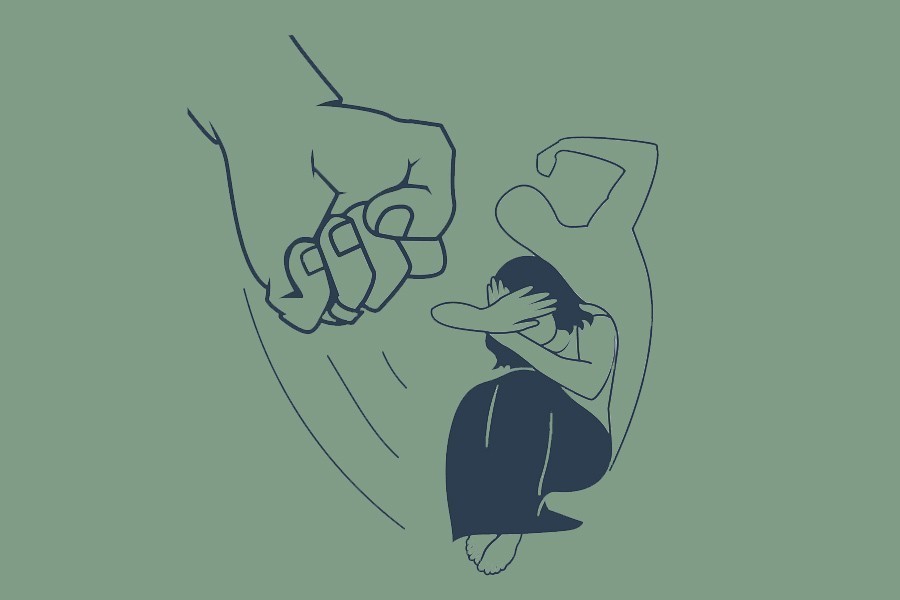Infamous domestic violence is not confined to the four walls in poor and underdeveloped countries. During the first wave of coronavirus pandemic, especial police squads had to be on their toes to respond to SOS calls from the victims of domestic violence or their friends and neighbours at an accelerated rate even in advanced and highly 'civilised' countries like France and the United Kingdom (UK). In France, wife beating and battering recorded a 30 per cent surge. By the third week of July, 40,000 calls were made to the National Domestic Abuse Helpline in Britain. The helpline that used to logging about 270 calls a day on an average in normal time saw an increase of 77 per cent in June alone. Reportedly, three women are killed every two weeks in the UK.
Worldwide, domestic violence increased by 20 per cent during the earlier lockdown. No wonder, the United Nations (UN) was prompted to term the rising incidence of intimate partner violence a 'shadow pandemic' alongside Covid-19. Now the second wave of the pandemic is sweeping Europe with some of the Balkan countries largely spared earlier becoming Covid-19 hotspots. Fresh lockdowns have already come into effect in many of those countries. To what level is the intensity of wife or intimate partner bashing going to surge in European regions during the second wave?
Reports have it that domestic violence is not uncommon even among celebrities in the West. In most cases, they remain 'underreported, stigmatised and in the shadows' for the very scandalous nature of such incidents. The other compelling factor is the threat of lawsuit, particularly when the onus is on the victim to prove physical violence perpetrated on her by the so-called loved ones. Recently, the verdict on a protracted lawsuit of libel filed by highly popular actor Johnny Depp against his ex-wife Amber Heard has, instead of rehabilitating his reputation, tarnished it further for physical abuse of the latter.
Now what are the reasons behind gender aggression irrespective of classes? Is violence in the male blood? There are, of course, cases of reverse aggression but those are few and far between. So, it is quite intriguing to know that both developed and underdeveloped countries, high society and segments wallowing at the bottom are not free from this outrage against girls and women. Both at home and outside, if not mathematically half ---at least a significant number ---of the world population is at risk of falling prey to physical and sexual aggression. This by no means is a war of sexes. Globally one in three women or girls has been subjected to gender abuse or violence in her lifetime.
Surprisingly, in the majority of tribal and indigenous communities domestic and sexual violence is mostly an unheard-of phenomenon. More than a dozen indigenous peoples even do not have a word for 'rape' in their languages. This shows the man-woman relationship is based on respect, trust and freedom of consent. Of course, matriarchal communities have always been free from many of the sexual aberrations of so-called civilised societies.
At last the Oxford Dictionary has felt the need for redefining 'woman'. Why? Because the sexist connotation no longer fits into the scheme of things. The Oxford University Press clarifies that there has to be a gender-neutral definition of both man and woman. So, a woman is a 'person's (instead of a man's) wife, girl friend or female lover'. But a mere change in definition will not restore gender equality nor will it bring an end to domestic and sexual violence against girls and women.
If violence against women in high society is rooted in use or abuse of drug and alcohol, it is mostly embedded in economic inequality and related depravity triggering unbearable mental stresses and strains. Arrogant but powerless males with a chauvinistic attitude release their frustration cruelly or ruthlessly on their partners who depend on them for food and shelter. Ancient societies did not consider girls and women sex objects or commodities as today's societies do. The indigenous communities are still free from this vice. The remains of a woman hunter, who lived 9,000 years ago, along with her stone tool kits in Andes Mountains of Peru even challenge the hunter-gatherer theory.
In today's world fraught with intrigues and all kinds of sexual aberrations, different approaches to the problem of gender violence are needed. Only a few of those have yielded positive results. Community-based interventions broadly of two categories have been successful in containing the problem. The first category directs focus to both the victim and perpetrator. Both are trained to get over the problem through participatory group discussion, counselling and when possible arrangement for alternative livelihoods. The second one involves wider community mobilisation. But essentially, they engage actors and activists of a wider range such as survivors of physical assault, reformed men, community leaders, the police, health workers and political leaders. In Jharkhand, India such social mobilisation has made quite an impact.
The idea is to sensitise communities about the ills of domestic and sexual violence. Actually, a change in the mindset responsible for domestic violence can work wonder when it comes to sexual offences outside of home. As charity begins at home, the extension of the perception gradually helps reduce violence against women on both fronts.


